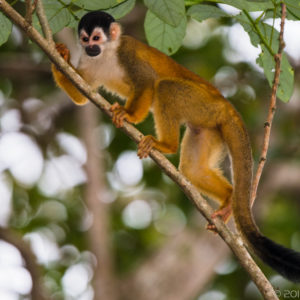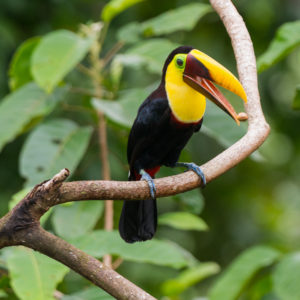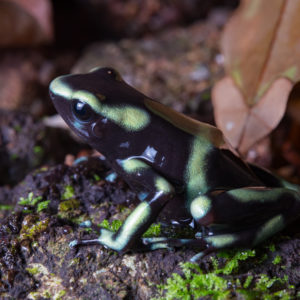My foot plunged through cool rushing water to find the firm purchase of a pebbled streambed. The shallow creek that emerged from beneath an arch of lush jungle foliage was both beckoning and mysterious, and upstream we went with the sound of Pacific Ocean waves pounding the wild beach behind us. “You watch the left bank and I’ll watch the right,” said my companion, Belgian-born naturalist Rinaldo Mulder. After a few minutes of wading, he calmly motioned me over to some damp leaf litter beside a moss-covered log. “There she is,” he whispered.
Mulder’s eagle eyes had located the tiny rainforest denizen that we were looking for, Phyllobates vittatus – a Golfo Dulce poison dart frog. About an inch long, and glossy black with striking orange and turquoise markings, she blended perfectly against the wet reflections and dark tones of the decomposing leaves that were her home. A single quick hop had announced her presence.
While Mulder kept an eye on the frog, I spread my tripod low and mounted my standard macro rig – a Nikon D3X and 200mm Micro-Nikkor. An off-camera softbox would provide illumination in the subdued light under the rainforest canopy. My heartbeat quickened as I moved in close and peered through the viewfinder. The fragile little creature was transformed into a formidable predator. How very fortunate I was to be so close to this creature in its native habitat – a primeval rain forest at the southern tip of the Osa National Wildlife Refuge on Costa Rica’s Pacific coast. Over the next several days of exploration and discovery, I would be reminded again and again of just how special this place is.
It’s hardly a coincidence that I had selected the Osa Peninsula for a project on tropical amphibians. Around the world, amphibian habitats and populations are experiencing rapid decline, and throughout the tropics the ecosystems that host the greatest amphibian biodiversity often face the greatest threats. From Borneo to Brazil to Madagascar, climate change, deforestation, agricultural expansion, pollution, and the fungal disease chytridiomycosis have combined to take a terrible toll, leaving almost a third of all known amphibian species listed as “threatened” – or worse – on the Red List maintained by the International Union for the Conservation of Nature (IUCN). Our little friend, the endemic Golfo Dulce poison dart frog, is listed as “endangered,” but on the Osa, dozens of native amphibian species seem to be thriving.
Home to 2.5% of all known species of life on Earth and more than half of all animal and plant species present in Costa Rica, the Osa Peninsula offers a shining example of conservation success through sustainable ecological stewardship. The Osa National Wildlife Refuge, an ingenious 4,260-acre land management program established as a partnership of private landowners and the Costa Rican government, is part of a contiguous 15,000-acre ecological corridor preserving an area the size of Manhattan south of the Corcovado National Park boundary all the way to the tip of the peninsula. Since its establishment in 1999, the refuge has focused on conservation and eco-tourism with a small environmental footprint, simultaneously serving the economic interests of the local community and the health of the ecosystem itself.
The biological vitality here is impossible to miss – searching for exotic wildlife consists of little more than opening one’s eyes. Scarlet macaws are found here in greater density than anywhere else in their native range, and hundreds of other tropical birds are abundant.
Four species of monkey – white-faced capuchin, mantled howler, Geoffrey’s spider, and the red-backed squirrel – cruise the forest canopy. The beach is undeveloped from the tip of the peninsula all the way to Corcovado National Park fourteen miles away, and provides important nesting ground for leatherback, olive ridley, hawksbill, and green sea turtles. The refuge is the domain of five wildcat species – jaguars, ocelots, jaguarundis, margays, and pumas – and is also home to two-toed sloths, stunning insects like metallic-blue morpho butterflies, basilisk lizards, and plant species numbering no fewer than 4,000.
More than twenty individual properties make up the Osa Wildlife Refuge, most of which were bought up in the 1980s and 1990s specifically for the conservation of this important biological corridor. For the most part these are entirely undeveloped, handed over by the owners for ecological management by Conservación Osa, the local conservation organization. Two refuge properties are eco-tourism businesses, including El Remanso, a 150-acre parcel of primary-growth rain forest running from a ridge-top 350 feet above sea level all the way down to the pristine beach. The sloping forested landscape funnels rainwater into creeks that drop precipitously over stunning waterfalls into fern-rimmed pools. A lagoon just off the beach is home to a shy, six-foot spectacled caiman. Blending in perfectly with its remarkable setting, the lodge at El Remanso has a tiny ecological footprint by design. Totally off the grid, its electricity is generated by a micro-hydro facility and solar panels. 92% of its waste is either recycled or composted. These behind-the-scenes efficiencies go largely unnoticed by guests, who experience stylish accommodations and a welcoming atmosphere more like a reunion of old friends than anything else.
Regarding the positive effects of eco-tourism on the Osa, El Remanso co-owner Daniel Gehring says, “I feel that these types of resorts have a very positive influence on the preservation of the associated ecosystems and wildlife. Successful conservation has a lot to do with the local community; it has a lot to do with economic reasons. If you make conservation good for the local community from an economic point of view, then you have won a big battle.” In addition to being locally valued employers and superb hosts, however, Gehring and his wife Adriana Domenech are passionately dedicated stewards of the forest and its many inhabitants. They point to the frogs as one of the key indicators of conservation success at El Remanso and the broader Osa biological corridor.
Amphibians are often referred to as canaries of the ecological coalmine – important indicators of environmental health. Herpetologists are quick to note that scientific research on Osa amphibian populations is lacking. According to Dr. Bill Lamar of the University of Texas, most studies in the area have focused on “identification and range as opposed to abundance and ecology.” Dr. Lamar adds that the numerous local microclimates make thorough study of amphibian populations challenging. “One of the problems is that there are distinct areas on the Osa and the adjacent mainland, at least in terms of humidity,” he says. This lack of detailed research makes it difficult to determine exactly how global warming and climate change – experienced so far as wetter rainy seasons and warmer, drier dry seasons – will impact amphibians here in the long term. Mulder points out that changing weather patterns will likely have mixed effects: “More rain during the wet season could be good for some frogs, but higher peak levels in the creeks would also wash out the leaf litter on the banks, and that’s exactly the environment that Golfo Dulce poison dart frogs need to reproduce.” Over the last two decades, however, the experiences of local naturalists and visiting biologists suggest that population trends tend to be stable so far and may be increasing in some areas, particularly in secondary-growth forest that has been provided the protection it needs to recover.
Since the creation of the Osa refuge, a number of key threats that impact frog populations around the world have been locally eliminated or kept in check. Non-native species that might out compete or prey upon native amphibians have yet to become a problem. The practice of poaching for the international exotic pet trade, once common, appears to have been reduced dramatically with the creation of new laws protecting wildlife and greater awareness of the economic value of local biodiversity. Commercial logging has ended within the refuge. The absence of mining or significant agriculture has left the surface water free of heavy metals or pesticides. Elsewhere, runoff of agricultural fertilizer and livestock waste into rivers and lakes leads to algae blooms and a resulting explosion in populations of aquatic snails that are a key vector for trematode worms responsible for debilitating deformities in frogs.
The Osa frogs obviously benefit from the health of the ecosystem in general, but Conservación Osa and local land owners have also taken measures to encourage favorable conditions. “My impression is that we have been seeing greater numbers and diversity of amphibians at El Remanso in part due to various practices we have put in place,” says Gehring, who has landscaped the area around the lodge with native plants favorable to the frogs and recently created a small frog pond. Of course, it is the healthy rainforest ecosystem that does the bulk of the work, and for any visitor here it is an inescapable fact that the frog species here are present in great abundance.
Within two days of my first outing with Rinaldo Mulder, I had encountered a dozen different frog species on my walks through the forest. Within five days, I had found fifteen Golfo Dulce poison dart frogs on the banks of the creeks. “We used to see them only in one particular spot, but now we find them at various locations in several creeks,” says Mulder. He added that a biologist who visited recently managed to document thirty different amphibian species during a single nighttime walk. Some of the native species include the “gaudy” red-eyed tree frog, masked tree frog, gladiator tree frog, cane toad, rain frog, glass frogs, and two more species of colorful poison dart frog – the green-and-black and the granular, the latter of which is often described as a red frog wearing green tights. By the way, poison dart frogs don’t bite and are perfectly safe to photograph up-close, but you wouldn’t want to lick one.
If frogs aren’t your taste, the Osa is a bird photographer’s paradise, providing important habitat for around 400 species. Hummingbirds feed from heliconias and other brilliantly colorful tropical flowers while chestnut-mandibled toucans feast on a smorgasbord of arboreal fruits. Showy violaceous trogons, blue-crowned manakins, and red-legged honeycreepers stand out in brilliant contrast to the dark forest. Ibis, jacanas, green-backed herons, and purple gallinules wade the rivers and streams. Birds of prey like black hawks, caracaras, roadside hawks, and king vultures survey the landscape in search of their next meal. Perhaps the bird photographer’s greatest prize is the elusive harpy eagle.
Considering the wild nature of the landscape, access for photographers is very good indeed. Well-maintained trails lead through the forest to old-growth trees, creeks, waterfalls and beaches. Observation platforms high in the forest canopy provide an unusual vantage point, and the restaurant deck at El Remanso is a superb wildlife-viewing platform, overlooking fruiting trees that attract macaws, toucans, and monkeys. It’s a good idea to bring a long lens to breakfast.
There are a few things that a photographer visiting the Osa Peninsula probably ought to bring along: a long telephoto, a macro lens, flash with off-camera capability, and a softbox or light tent to diffuse the strobe when working with frogs and other macro subjects. A tripod that is sturdy enough to handle a big lens, light enough to hike with, and that gets low enough for macro work close to the ground is helpful too. This December, when I travel to El Remanso with my friend Daniel Beltrá to teach a Visionary Wild workshop, my Think Tank backpack will be loaded with Nikon D4 and D800e bodies, Nikkor 500mm f/4 VR, 200mm Micro-Nikkor, 24-70mm f/2.8, 70-200 f/2.8 VR, 1.4x and 2x teleconverters, polarizing filter, and an SB-900 flash or two. In my Patagonia rolling duffel, I’ll carry a large Lumiquest softbox, a Lastolite Light Tent, and a Really Right Stuff TVC-24L tripod with BH-55 ball head and Wimberley Sidekick. A waterproof cover will be in my pack too – it is a rainforest after all.
In fact, after a rain is the perfect time to go looking for frogs. In addition to the Golfo Dulce and granular poison dart frogs that are most easily found in the leaf litter along the creek banks, the semi-arboreal green-and-black poison dart frogs can best be found as they traverse the ground when moving from tree to tree. The various tree frog species tend to find a perfectly camouflaged position to lay low and sleep during the day, becoming active as the sun goes down. They can be found by homing in on their distinctive calls, aided by a headlamp once close. The photogenic red-eyed tree frog is commonly found on vegetation near the El Remanso pool – perfect for a pre-dinner shoot. At night, it is often easiest to photograph handheld with flash, freezing subject and camera motion with the quick strobe. A softbox, handheld or on a flash bracket, can be positioned just out of frame for soft, even lighting.
Logistically, a visit to the Osa is an exotic adventure balanced with surprising convenience. The Costa Rican capital of San Jose is a short hop from the U.S., and the quick puddle-jumper flight over the mountains and along the coast to Puerto Jimenez is spectacular. From there, visitors can rent a vehicle (4WD recommended), arrange ground transfers with their lodging, or hire a local taxi. The unpaved road to El Remanso fords three small rivers and passes through areas that are perfect for photographing monkeys as they cross in the low canopy overhead. Once deep in the rain forest, one can’t help but feel very, very far away from all.
Next time, I’ll be in search of glass frogs. Semi-transparent, they’ve evolved greenish bones as part of their impressive camouflage. I’ve heard their distinctive high-pitched chirps all around me in the jungle, and I’ve photographed their tadpoles developing inside transparent egg cases clinging to leaves above a creek, but so far adults have eluded me. In the Osa, there is always something new to discover. Let’s hope it stays that way.






